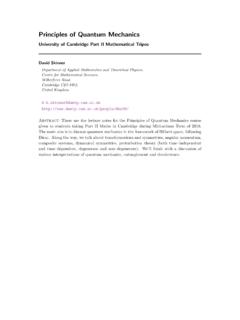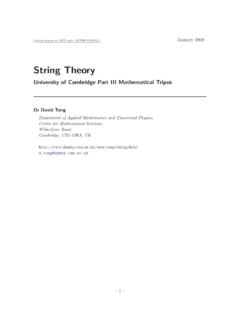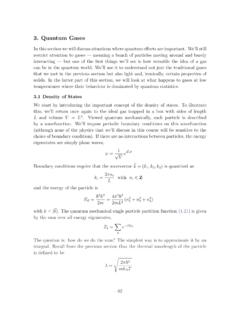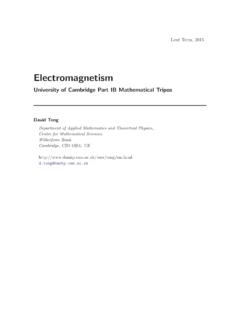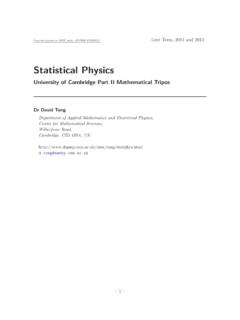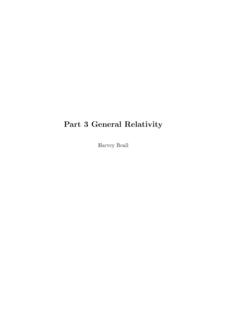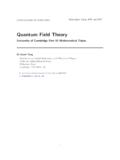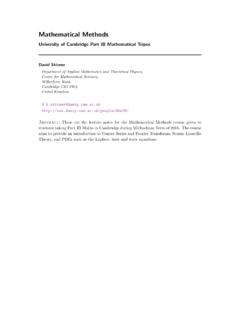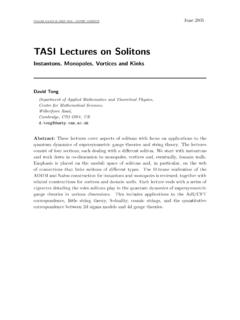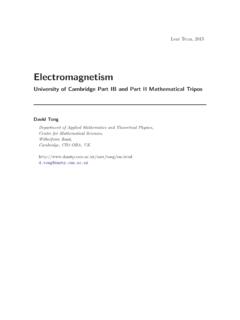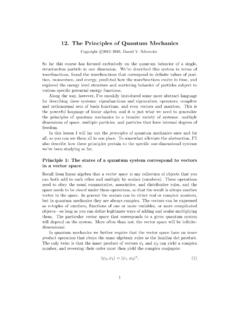Transcription of Part II Principles of Quantum Mechanics Michaelmas 2014
1 Part II Principles of Quantum MechanicsMichaelmas 2014 Prof. HorganNovember 28, 2014 Contents1 Introduction12 Dirac States and Operators .. Observables and measurements .. Time evolution and the Schr odinger Equation .. and Representations .. Position and momentum basis wavefunctions .. Simultaneous Measurements and Complete Commuting Sets ..153 The Harmonic Analysis using annihilation, creation and number operators .. Importance of the oscillator applications in outline ..204 Pictures and Unitary operators .. Schr odinger and Heisenberg Pictures .. Quantization ..265 Composite Systems and Identical Tensor products .. Spin .. Multiparticle states: bosons and fermions .. Spin and statistics.
2 Two-particle examples .. Pauli Exclusion Principle and Atomic Structure ..346 Perturbation The non-degenerate case .. Degenerate case ..407 Angular of orbital angular momentum .. General analysis of angular momentum eigenstates .. representations .. Some physical aspects of angular momentum and spin .. of angular momentum ..528 Transformations and Introduction and an Example .. Generators and conservation laws .. Angular Momentum and Rotations .. Reflections and Parity ..649 Time-dependent Perturbation The interaction picture .. Transition rates and Fermi s Golden Rule .. of radiation/EM field with atoms .. Emission and absorption of photons ..7510 Quantum Classical and Quantum Data .. EPR experiment and Bell s inequality.
3 Density operators and hidden sectors ..82 CONTENTSiiiBOOKS E. MerzbacherQuantum Mechanics , 3rd 1998 (various prices) Bransden and JoachainQuantum Mechanics , 2nd 2000( 50-60 on Amazon) J. Binney and D. SkinnerThe Physics of Quantum Mechanics , 3rd 2013 ( ) DiracThe Principles of Quantum University Press 1967reprinted 1999 ( ). IshamLectures on Quantum Theory: Mathematical and Structural College Press 1995 (around 18) S. GasiorowiczQuantum Physics, 3rd International 2003 of these books are expensive new and there are a lot of pedagogic books onquantum Mechanics , so it s good to look at those in the library since many books aregood in one area but poor in another. Other books may be recommeneded throughthe Introduction Recall features of elementary (IB) Quantum Mechanics : wave-particle behaving like particles , light quanta, pho-tons and vice-versa; interference of electrons passing through crystal grating andelectron microscope.
4 To make this more precise need: wavefunction pxqfor particle. Probability density| pxq|2; probability is in-trinsic to the theory. 0bservables become (hermitian) operators on wavefunctions. Lack ofcommutation limits simultaneous measurement leads to precise version of un-certainty principle. Schr odinger s equationspecifies dynamics (evolution in time) and determinesenergy is enough to understand , the hydrogen atom and transcends classicalphysics. Aim of this course: reformulate QM in a more powerful, abstract, flexible and useful form:Diracformalism. This allows a simpler analysis of known problems such as the har-monic oscillator and is also the clearest way to understand lots of more novelproperties, for example: the spin of particles; symmetries ( , translations and rotations) and conservation laws; identical particles; it provides the framework for quantizing other, more general, systems , EMfield, and ultimately other forces leading to the Standard Model of elementaryparticles.
5 Will not dwell on applications in any detail, but will keep track of what the mathe-matical formalism is for. Assume IB QM and IA Dynamics but no electromagnetism beyond Coulomb s lawand intuitive ideas about :1. Dirac Harmonic Pictures of Composite systems and identical Perturbation Angular Transformations and Time-dependent perturbation Quantum DIRAC FORMALISM22 Dirac States and OperatorsA Quantum state is described at each instant by astate| ywhich belongs to a complexvector spaceV. Then| y,| y PV | y` | y PV@ , PC.( )Physically this is the superposition principle leading to wave-like behaviour (interfer-ence). However, these states are not wavefunctions but we will see that they carry allthe Quantum information that describes thestateof the system concerned in a verygeneral are alsodualor conjugate statesx |which belong to the dual spaceV.
6 Bydefinition, states and duals can be combined/paired to give a complex number:x |loomoon bra ,| yloomoon ket x | yloomoon bra(c)ket or formallyV: V C,( )withx | 1| 1y ` 2| 2y 1x | 1y ` 2x | 2y, 1x 1| ` 2x 2| | y 1x 1| y ` 2x 2| y,( ) , PC. This is the definition of the dual as a vector space of statesVand the dualV:come with an inner-product which can bedescribed as a one-to-one correspondence between states and duals:V V:with| y x | p | yq:(use same label for corresponding states)and | y` | y x | ` x |.( )The inner product isV V C| y,| y x | y p| yq:| y,( )and is assumed to obeyx | y x | y hermitian | y 2 x | y 0 (real from above)with | y 2 0iffi| y 0.( )This means that the inner product ispositive semidefinite. Note that knowingx | yfor allx |determines| yuniquely and physical content of any state is unaltered by changing| y | y p 0q.
7 Weshall usually normalize states by | y 2 1 but still have the freedom to change| y ei | y. The absolute phase of a single state never has any physical significance,2 DIRAC FORMALISM3but relative phases in combination such as | y` | ycan be significant; for example,for interference spaceVis complete; we assume appropriate sequences or series converge. Acomplete inner product space of this kind is aHilbert spaceand this term is oftenused for the spaceVin be either finite or infinite dimensional and we shallsee examples of operatorQis a linear map on states,V V:| y Q| y,( )and, by definitionQ | y` | y Q| y` Q| y.( )The same operator can be regarded as acting to the left on dual states,V: V::x | x |Q ,( ) x |Q | y x | Q| y @ | yor simply x |Q| y.
8 ( )For anyQthehermitian conjugateoradjointis an operatorQ:defined byx |Q: Q| y :,( )or, equivalently,x |Q:| y Q| y :| y x |Q| y @ | y,| y.( )Simple consequences are A` B : A:` B:,`AB : B:A:,( )for anyA, |pABq:| y pABq| y :| ydefn ofpABq: A| 1y :| y| 1y B| y x 1|A:| ydefn ofA: B| y : A:| y x |B:A:| ydefn ofB:.( )True for all| y,| yand result DIRAC FORMALISM4 For any operatorQcall| y p 0qaneigenstateofQwith eigenvalue ifQ| y | y.( )Equivalently (taking:of this)x |Q: x |.( )For generalQ, can be particular importance are commutators of operatorsrA,Bs AB BA rB,As.( )We have the identitiesr 1A1` 2A2,Bs 1rA1,Bs ` 2rA2,BsrA, 1B1` 2B2s 1rA,B1s ` 2rA,B2slinearity( )rA,B1B2s rA,B1sB2`B1rA,B2srA1A2,Bs rA1,BsA2`A1rA2,BsLeibnitz properties( )rA,rB,Css `rB,rC,Ass ` rC,rA,Bss 0 Jacobi identity( ) Observables and measurementsAn operatorQishermitianorself-adjointifQ: Q.
9 ( )Such operators are calledobservablesbecause they correspond to physical, measur-able, quantities , position, momentum, energy, angular momentum. Key results forany hermitianQ:(i) All eigenvalues are real.(ii) Eigenstates with distinct eigenvalues are orthogonal.(iii) The eigenstates form a basis forV(and their duals forV:). So any state can beexpanded in terms of (written as a linear combination of) the prove (i) and (ii) and assume (iii).(i)Q| y | yandx |Q: x | x |Q x |sinceQis hermitian x |Q| y x | y x | y.( )But | y 2 x | y 0p| y 0qand so deduce .( )2 DIRAC FORMALISM5(ii) Let|nybe eigenstates ofQwith eigenvalues qnreal, withna discrete labelpossibly of infinite |ny qn|nyandQ|my qm|myorxm|Q qmxm| xm|Q|ny qnxm|ny qmxm|ny.( )Soqn qm xm|ny these three properties we have For any observableQthere is an orthonormalbasisof eigenstatest|nyufor the spaceof statesVwithQ|ny qn|ny,xm|ny mn.
10 ( )We speak ofdiagonalizingQby choosing the basis to be the eigenstates| means that a general state| ycan be expanded as| y n n|ny,( )where n xn| the state to be properly normalized | y 2 x | y 1 m mxm| n n|ny n| n|2 1.( )There might be several states with the same eigenvalue . Define theeigenspacefora given eigenvalue byV t| y:Q| y | yu,( )which has the basist|ny:qn is the number of states in this basis, or dimV . We say that isnon-degenerateif the degeneracy is that passing from our three key results to the conclusionp qis achieved bychoosing an orthonormal basis for eachV :(ii) ensures that these spaces are mutually orthogonal;(iii) implies that the sum of all the eigenspaces isV, the entire space of a measurement ofQwhen the system is in state| yimmediately The result is an eigenvalue, , DIRAC FORMALISM6 This value is obtained with the probabilitypp q n:qn | n|2.
